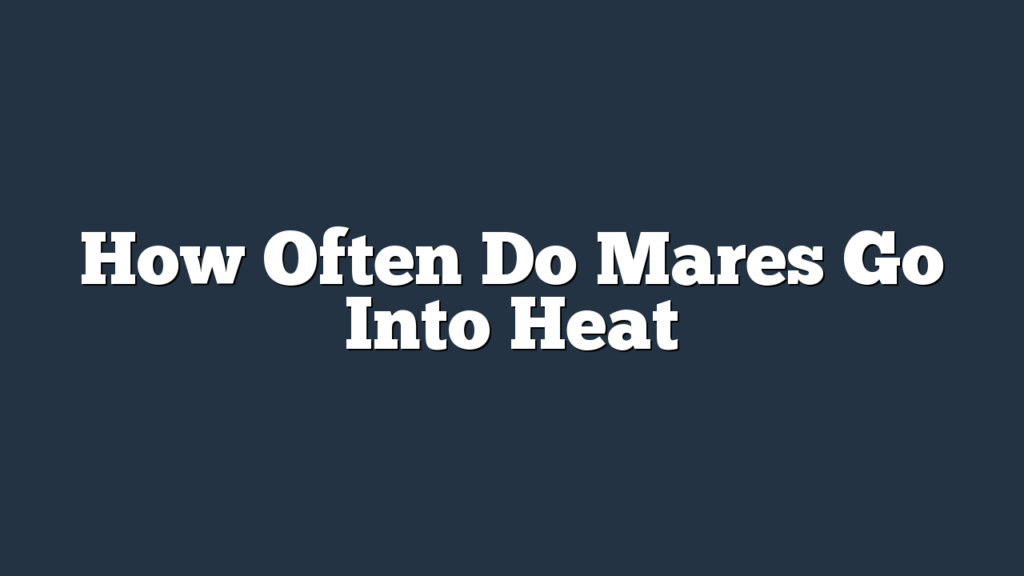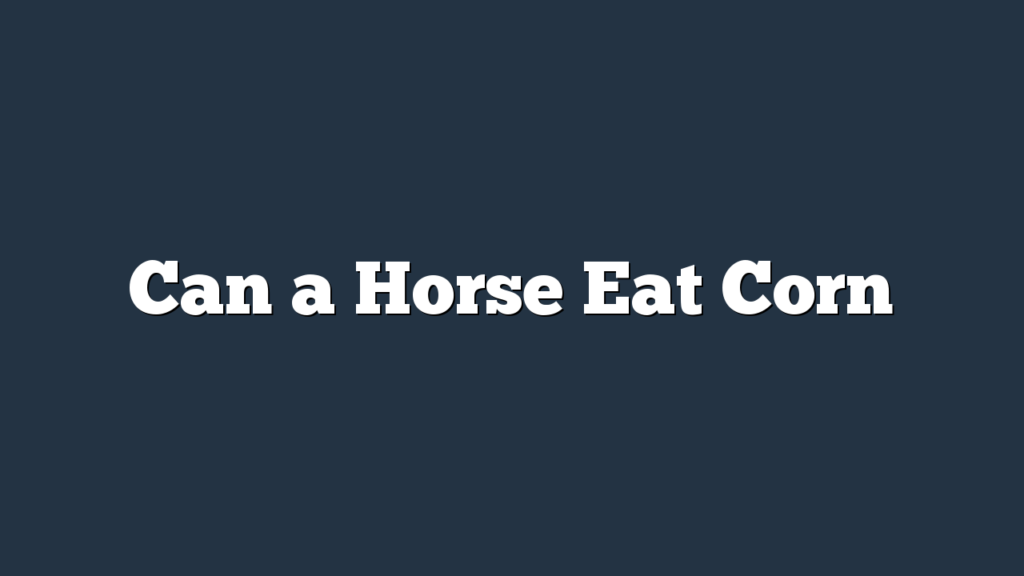Do you ever wonder how often your mare goes into heat? Well, we’ve got the answers for you! In this article, we’ll explore the basics of mares’ heat cycles, including the length and frequency of their estrous cycles.
We’ll also discuss the factors that can affect their heat cycles and the signs and symptoms to look out for. So, if you’re looking to better understand and manage your mare’s heat cycles, keep reading!
The Basics of Mares’ Heat Cycles
Mares typically go into heat approximately every 21 days. During this time, their bodies go through a series of hormonal changes that prepare them for ovulation. Understanding the timing of ovulation is crucial for successful breeding and reproductive management of mares.
Ovulation timing is essential when it comes to breeding mares. It helps determine the best time to breed the mare for a higher chance of successful conception. The estrous cycle of a mare consists of several phases, with ovulation occurring in the middle of the cycle. By monitoring the mare’s behavior, vaginal discharge, and reproductive tract palpation, veterinarians and breeders can estimate when ovulation is likely to occur.
Hormonal changes in mares play a significant role in their heat cycles. The follicle-stimulating hormone (FSH) and luteinizing hormone (LH) are responsible for the development and maturation of the follicles. As the follicles grow, they produce estrogen, which triggers behavioral and physical changes in the mare. These changes include increased urination, restlessness, and receptiveness to a stallion.
Length of Mares’ Estrous Cycle
Now let’s talk about the length of mares’ estrous cycle. The duration of a mare’s cycle can vary, with an average length of about 21 days. However, it’s important to note that individual mares may have cycle variations due to factors such as age, health, and seasonality.
Understanding these variations is crucial when it comes to breeding during the mare’s estrus phase.
Cycle Duration Variations
During the estrous cycle, you may notice variations in the length of your mare’s cycle duration. These cycle variations can be influenced by hormonal changes within the mare’s body. It is important to understand that each mare is unique, and her cycle duration can vary from one individual to another. To give you a better understanding of these variations, let’s take a look at the table below:
| Cycle Duration (Days) | Description | Possible Influences |
|---|---|---|
| 18-24 | Short | Hormonal imbalances |
| 21-23 | Normal | Optimal hormonal balance |
| 25-30 | Extended | Stress, illness, or age-related |
| 30+ | Prolonged | Ovarian cysts or reproductive issues |
Factors Affecting Cycle
To understand the factors affecting the length of your mare’s estrous cycle, it’s important to consider various factors that can influence her reproductive cycle duration.
One of the key factors influencing fertility in mares is nutrition. Proper nutrition plays a vital role in maintaining a healthy reproductive system and ensuring regular cycles. Inadequate nutrition can lead to hormonal imbalances and irregular cycles. A diet lacking in essential nutrients, such as vitamins and minerals, can negatively impact the mare’s reproductive health.
On the other hand, a well-balanced diet that meets her nutritional requirements will support optimal reproductive function. Providing your mare with a diet that’s rich in high-quality forage, supplemented with the necessary vitamins and minerals, can help regulate her cycle and improve fertility.
Therefore, it’s crucial to pay attention to her nutrition to ensure a healthy and regular estrous cycle.
Breeding During Estrus
When breeding mares during their estrus cycle, it’s important to consider the length of their cycle. The length of the estrous cycle can vary between mares, typically lasting around 21 days. However, it can range from 19 to 26 days. Understanding the length of the cycle is crucial for successful breeding techniques and managing reproductive behavior.
Here are five key points to keep in mind:
- Mares in heat are receptive to breeding and should be monitored closely for signs of estrus.
- Timing is critical, as breeding should ideally occur during the peak of estrus to maximize the chances of conception.
- Regular ultrasound examinations can help determine the stage of the cycle and pinpoint the optimal breeding time.
- Artificial insemination can be performed using fresh, chilled, or frozen semen, depending on the mare’s cycle and fertility.
- Breeding management techniques, such as teasing and hormonal treatments, can be employed to regulate the mare’s estrus cycle and improve reproductive success.
Frequency of Mares’ Heat Cycles
You can expect mares to go into heat approximately every 21 days. This regular occurrence is due to hormonal regulation within their bodies. The heat cycle, also known as the estrous cycle, is controlled by a complex interplay of hormones that prepare the mare for potential breeding and pregnancy.
Hormonal regulation of the mare’s heat cycle involves the release of various hormones, including follicle-stimulating hormone (FSH), luteinizing hormone (LH), and progesterone. FSH stimulates the development of ovarian follicles, which house the eggs, while LH triggers ovulation. Progesterone, on the other hand, helps maintain pregnancy if fertilization occurs.
It’s important to note that there can be seasonal variations in the frequency of mares’ heat cycles. In some cases, mares may experience longer or shorter cycles depending on the time of year. This is particularly evident in mares that live in temperate climates, where the lengthening or shortening of daylight hours can influence their reproductive cycles.
Understanding the frequency of mares’ heat cycles is crucial for breeders and horse owners alike. By knowing when a mare is likely to come into heat, breeders can plan their breeding programs more effectively. Similarly, horse owners can anticipate changes in their mare’s behavior and take appropriate measures to ensure their well-being during these periods.
Factors Affecting Mares’ Heat Cycles
Now let’s explore the factors that influence your mare’s heat cycles.
Hormonal fluctuations and environmental conditions play a crucial role in determining the frequency and intensity of her cycles.
Additionally, factors related to breeding and reproductive health can also impact her heat cycles.
Understanding these factors will help you better manage and care for your mare during her reproductive cycles.
Hormonal and Environmental Factors
Understanding the hormonal and environmental factors that influence mares’ heat cycles is essential for horse owners and breeders. These factors play a crucial role in determining the frequency and duration of a mare’s heat cycles.
- Hormonal regulation: The reproductive cycle of mares is controlled by hormones such as estrogen and progesterone. These hormones fluctuate throughout the cycle, leading to the onset and resolution of heat periods.
- Seasonal influences: Mares’ heat cycles are influenced by the changing seasons. They tend to have more frequent and regular cycles during the spring and summer months, while the frequency decreases during the fall and winter.
- Daylight duration: The length of daylight also affects mares’ heat cycles. Longer daylight hours stimulate the release of hormones, signaling the start of a new cycle.
- Social interactions: Mares’ heat cycles can be influenced by the presence of other horses, particularly stallions. Social interactions can trigger hormonal responses and affect the timing of heat periods.
- Environmental factors: Factors such as temperature, diet, and stress levels can impact a mare’s reproductive cycle. Changes in these environmental factors can disrupt the regularity of heat cycles.
Breeding and Reproductive Health
Factors such as breeding practices and overall reproductive health greatly influence the frequency and duration of your mare’s heat cycles. Proper breeding management is crucial to ensure successful reproduction. It involves carefully selecting the stallion, timing the breeding, and ensuring optimal conditions for conception.
Regular veterinary check-ups and monitoring of your mare’s reproductive health are essential in identifying and addressing any potential reproductive disorders. These disorders can affect the regularity and intensity of heat cycles. Common reproductive disorders in mares include uterine infections, hormonal imbalances, and ovarian cysts.
Treatment and management of these disorders can help regulate your mare’s heat cycles and improve her chances of conceiving. By prioritizing breeding practices and reproductive health, you can maximize the potential for successful breeding and ensure the overall well-being of your mare.
Signs and Symptoms of Mares in Heat
You’ll notice several signs and symptoms when your mare is in heat. Here are some common behavioral changes and physical signs to look out for:
- Increased urination: Your mare may urinate more frequently than usual during her heat cycle. This is a natural response to the hormonal changes happening in her body.
- Restlessness: Mares in heat can become agitated and restless. They may pace, paw the ground, or show signs of discomfort.
- Swollen vulva: One of the most obvious physical signs of a mare in heat is a swollen vulva. It may appear larger and more relaxed than usual.
- Frequent tail raising: Your mare may frequently raise her tail, exposing her vulva. This behavior is a way for her to attract the attention of potential mates.
- Changes in behavior towards other horses: Mares in heat may exhibit different behavior towards other horses. They may be more flirtatious or aggressive, especially towards stallions.
These signs and symptoms can vary from mare to mare, but they’re generally reliable indicators that she’s in heat. By being attentive to these changes, you can better understand and manage your mare’s reproductive cycle.
Managing Mares’ Heat Cycles
To effectively manage your mare’s heat cycles, it’s important to establish a consistent routine and observe any changes in her behavior and physical signs. Mares experience hormone fluctuations during their heat cycles, which can affect their mood and behavior. By understanding and managing these fluctuations, you can help your mare feel more comfortable and reduce any potential disruptions to her routine.
One way to manage hormone fluctuations is to provide a calm and stress-free environment for your mare. Stress can intensify heat cycles, so it’s essential to minimize any sources of stress in her surroundings. Additionally, regular exercise can help regulate hormone levels and reduce behavioral changes associated with heat cycles. Regular exercise also helps maintain a healthy weight, which can have a positive impact on hormone balance.
In addition to managing the environment and exercise, there are also natural remedies that can help alleviate the symptoms of heat cycles. Some owners find that herbal supplements such as chasteberry or raspberry leaf can help balance hormone levels and reduce the intensity of heat cycles. However, it’s important to consult with your veterinarian before introducing any new supplements to your mare’s diet.
Conclusion and Takeaways
To summarize, it’s important for mare owners to understand the factors influencing their mare’s heat cycles and take proactive steps to manage them effectively. By managing heat behavior and considering the impact of diet on heat cycles, you can help ensure the well-being of your mare and maintain a harmonious environment.
Here are some key takeaways:
- Maintain a balanced diet: Providing your mare with a well-balanced diet can help regulate her hormone levels and support a healthy reproductive system. Ensure she receives adequate nutrients and avoid excessive sugars and starches that can disrupt her heat cycles.
- Monitor behavior and signs: Pay attention to your mare’s behavior and signs of heat, such as increased vocalization, frequent urination, and flirting with other horses. This will help you track her cycle and anticipate when she may come into heat again.
- Consider hormonal interventions: If your mare’s heat cycles are causing significant disruptions or behavioral issues, consult with your veterinarian about potential hormonal interventions. They can provide guidance on the use of medications to manage her cycles effectively.
- Provide a suitable environment: Creating a calm and stress-free environment for your mare can help regulate her heat cycles. Minimize disruptions, maintain a consistent routine, and ensure she’s ample access to clean water, shelter, and exercise.
- Work with a professional: If you’re unsure about managing your mare’s heat cycles or have concerns about her behavior during this time, seek guidance from an equine reproductive specialist or experienced trainer. They can provide personalized advice and support to help you navigate this aspect of mare ownership.
Frequently Asked Questions
Can Mares Go Into Heat During Pregnancy?
During pregnancy, mares can still go into heat, but they won’t have multiple heat cycles at once. However, hormonal changes can occur, which may affect their behavior and reproductive processes.
Do Mares Experience Any Physical Discomfort During Their Heat Cycle?
During their heat cycle, mares may experience physical symptoms such as swelling and discharge. They may also exhibit behavioral changes like restlessness and increased vocalization. It is important to monitor and provide appropriate care during this time.
Are There Any Differences in the Duration or Intensity of Mares’ Heat Cycles Based on Their Age?
Duration differences and intensity variations in mares’ heat cycles can vary based on their age. Younger mares may have shorter and more intense cycles, while older mares may experience longer and less intense cycles.
How Long Does Each Heat Cycle Typically Last for a Mare?
The length and frequency of a mare’s heat cycles can vary, but typically each cycle lasts about 21 days. During this time, she may show signs of estrus and be receptive to mating.
Can Mares’ Heat Cycles Be Influenced or Controlled Through Nutrition or Diet?
Influence of diet on mares’ heat cycles is possible. Nutritional supplements can help regulate mares’ heat cycles. Consider consulting with a veterinarian to determine the best approach for your horse’s specific needs.
Conclusion
So, now you know how often mares go into heat. The length of their estrous cycle can vary, but on average it occurs every 21 days. However, this can be influenced by factors such as age and season.
Signs and symptoms of mares in heat include behavioral changes and physical cues. By understanding and managing their heat cycles, you can ensure the well-being and comfort of your mare.



